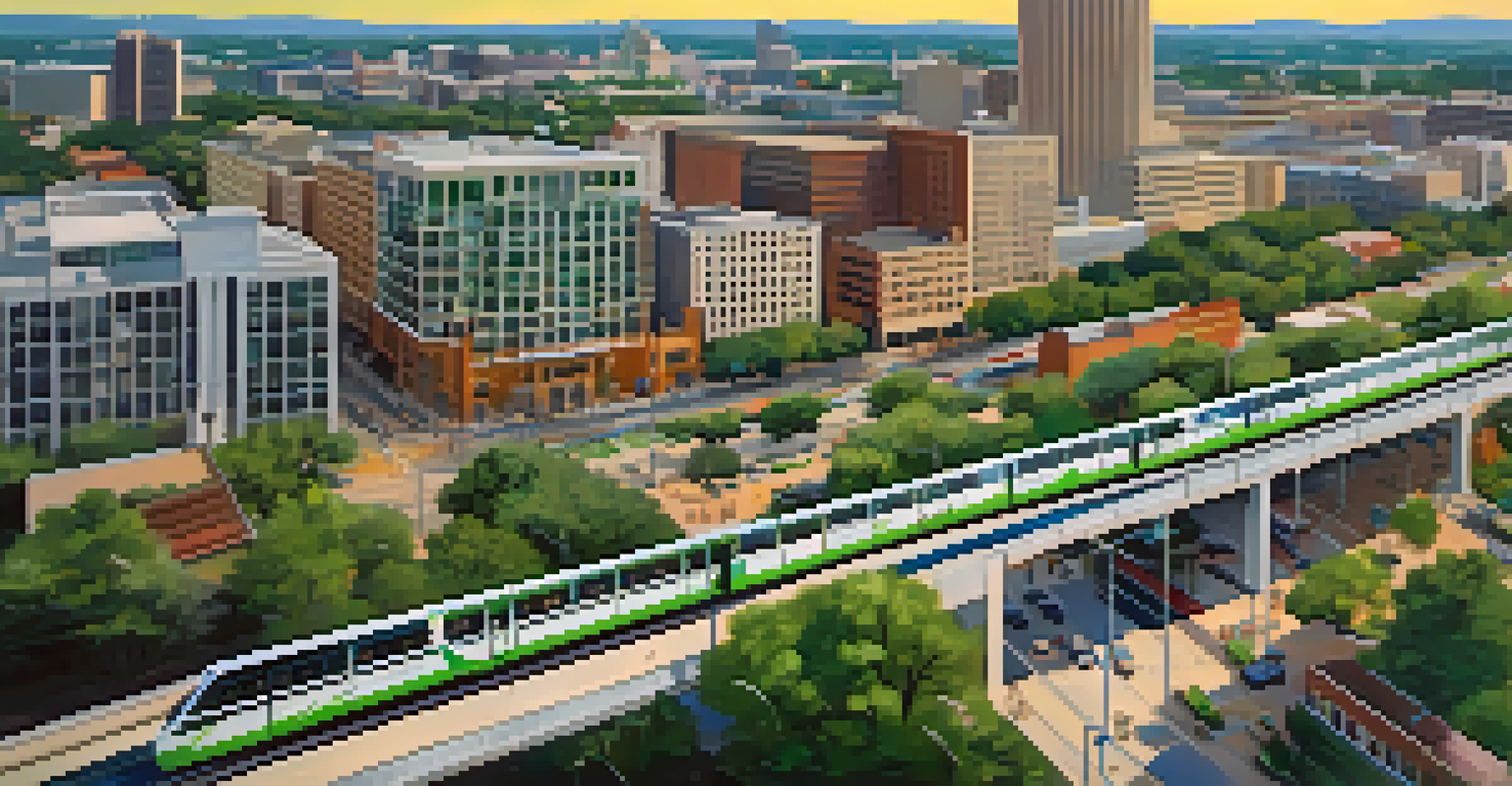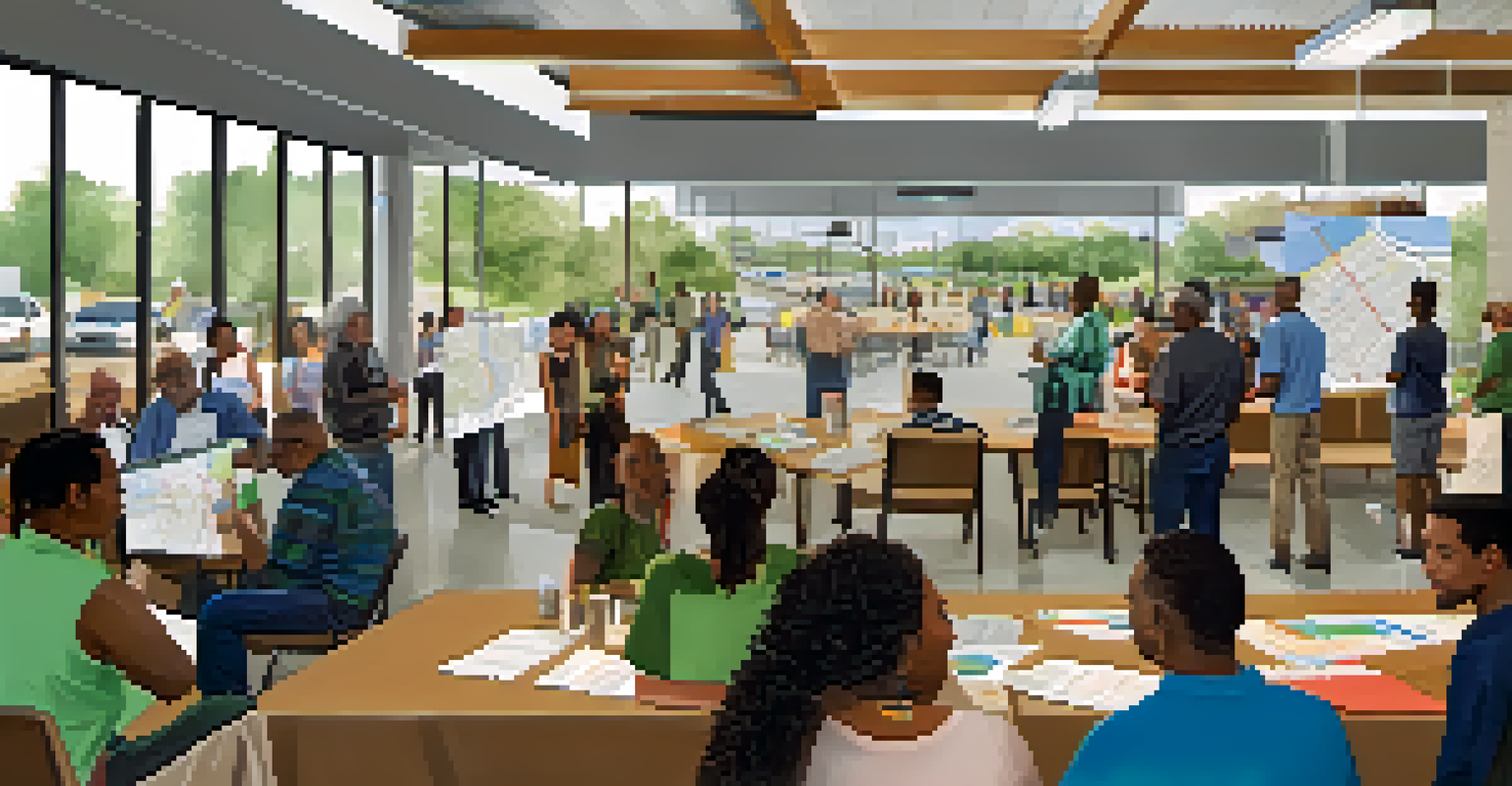Light Rail Development and Its Impact on Austin Commutes

Understanding Light Rail: A Quick Overview
Light rail is a form of urban transit that operates on dedicated tracks, often sharing roads with other vehicles. It’s designed to provide efficient and reliable transportation, connecting various parts of a city. In Austin, the development of light rail is seen as a crucial step toward addressing the growing traffic congestion.
Public transportation is a vital part of a city’s infrastructure, allowing for mobility and access to opportunities for all residents.
The concept of light rail isn't new; cities like Portland and San Diego have successfully implemented these systems to improve mobility. Austin's light rail project aims to provide a similar solution, making commuting easier for residents. This innovation is not just about transportation; it's about enhancing the quality of life in the city.
As Austin continues to grow, the demand for better public transit options becomes increasingly evident. Light rail can help reduce the number of cars on the road, leading to less pollution and a more sustainable urban environment. Understanding light rail is essential for grasping its potential impact on everyday commutes.
Current Commute Challenges in Austin
Austin is known for its vibrant culture, but it also faces significant commuting challenges. Traffic congestion has become a hallmark of daily life for many residents, leading to longer travel times and increased frustration. With rapid population growth, the existing road infrastructure struggles to keep pace.

Many Austinites spend hours in traffic each week, impacting their work-life balance and overall well-being. The city’s layout, combined with a lack of comprehensive public transit, exacerbates these issues. Commuting problems affect not just individuals but also the economy and environment, making solutions urgent.
Light Rail Eases Commute Challenges
Austin's light rail project aims to reduce traffic congestion and improve commuting efficiency in the rapidly growing city.
The need for an efficient transit system is more pressing than ever. Light rail can serve as a viable alternative to traditional commuting methods, offering a reliable way to navigate the city. By addressing these challenges, Austin can work toward a more accessible future.
The Vision Behind Austin's Light Rail Development
The vision for Austin’s light rail development is rooted in the desire for a more connected and accessible city. City planners and officials aim to create a system that integrates seamlessly with existing transportation methods. This vision includes not just light rail but also bus routes and bike lanes to encourage multimodal transit.
A well-designed public transit system is the backbone of a successful city, promoting not just mobility but also community and economic growth.
Creating a light rail system is about more than just transportation; it’s about fostering community. The goal is to link neighborhoods, employment centers, and cultural hotspots, making it easier for residents to navigate their city. By prioritizing accessibility, Austin can enhance social interactions and economic opportunities.
The light rail project represents a forward-thinking approach to urban planning. By investing in public transit, Austin aims to reduce reliance on personal vehicles and promote sustainable commuting practices. This vision is an essential step toward a more livable, connected city.
Anticipated Benefits of Light Rail for Commuters
One of the most significant benefits of light rail is the potential to decrease commute times for residents. By providing a reliable and efficient mode of transportation, light rail can help commuters reach their destinations faster. This improvement could lead to more free time and less stress for those who rely on public transit.
Additionally, light rail can contribute to environmental benefits by reducing the number of cars on the road. Fewer vehicles mean lower emissions, contributing to improved air quality in Austin. This positive impact aligns with the growing emphasis on sustainability and green initiatives within the community.
Community Engagement is Essential
Involving residents in the light rail planning process fosters a sense of ownership and ensures the system meets community needs.
The economic benefits of light rail are also noteworthy. A well-developed transit system can attract new businesses and enhance property values along its routes. As more people opt for public transit, businesses may thrive from increased foot traffic, creating a vibrant local economy.
Potential Drawbacks and Concerns
While the light rail project is promising, it’s not without its concerns and potential drawbacks. One major issue is the cost associated with developing and maintaining the system. Questions about funding and budget overruns often arise, leading to public skepticism about the project's feasibility.
Another concern is the impact on existing neighborhoods and traffic patterns. Construction can disrupt local businesses and residents, leading to frustration among those who may feel overlooked. It’s essential for city planners to communicate effectively with the community to address these concerns and minimize disruptions.
Lastly, there’s the challenge of ensuring that the light rail system meets the needs of all residents. Accessibility for those with disabilities and coverage for underserved areas must be prioritized. Balancing these factors is crucial for the success and acceptance of the light rail project.
Community Involvement in Light Rail Development
Community involvement is a critical aspect of the light rail development process in Austin. Engaging residents in discussions about the project can help address concerns and gather valuable feedback. Public meetings and forums provide platforms for community members to voice their opinions and contribute to planning.
This involvement not only fosters a sense of ownership among residents but also helps city planners design a system that meets the community's needs. By incorporating public input, the light rail can be more effective and user-friendly. Moreover, transparency in the planning process builds trust and support for the initiative.
Sustainability and Economic Growth
The light rail initiative promotes environmental benefits and economic development by attracting businesses and improving air quality.
Ultimately, successful light rail development hinges on collaboration between city officials and the community. When residents feel heard and valued, they are more likely to embrace the new transit system. This partnership can lead to a smoother implementation and a more successful outcome for everyone involved.
Looking Ahead: The Future of Austin's Commutes
As Austin moves forward with the light rail project, the future of commuting in the city looks promising. The integration of light rail into the existing transportation network could revolutionize how residents travel. With a focus on sustainability and efficiency, the city can pave the way for a more connected community.
The anticipated benefits extend beyond just transportation; they include economic growth, environmental improvements, and enhanced quality of life. As light rail becomes operational, it will likely influence urban development patterns, encouraging more walkable neighborhoods and reducing sprawl. This shift can lead to healthier lifestyles and stronger community ties.

In conclusion, the development of light rail in Austin represents a significant step towards modernizing the city’s transit system. By addressing current commuting challenges and engaging with the community, Austin has the opportunity to create a transit experience that meets the needs of its residents. The journey ahead may have its challenges, but the potential rewards are well worth the effort.